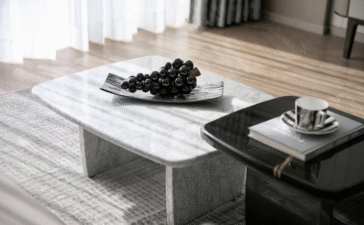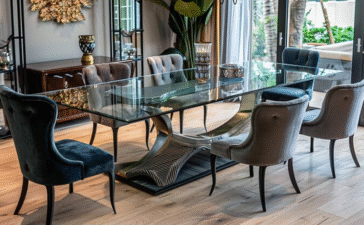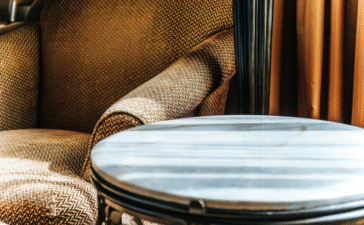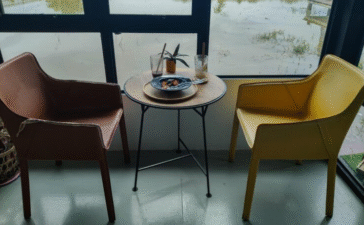Choosing the right interior doors can completely transform the feel of your home. It’s an element that combines daily function with overarching design. While many options exist, solid wood interior doors stand out as a premium choice for homeowners and designers alike. They offer an unmatched blend of durability, natural beauty, and a tangible sense of quality that can elevate any space.
This guide explores every aspect of solid wood interior doors. We’ll examine what defines them, the numerous benefits they bring, and how to choose the perfect style for your home. By understanding the materials, costs, and maintenance involved, you can make an informed decision and invest in doors that will last for generations.
What Are Solid Wood Interior Doors?
A “solid wood” door is exactly what it sounds like: a door constructed entirely from natural lumber, with no hollow spaces or engineered cores. This is the primary distinction between solid wood doors and their common alternatives, hollow core and solid core doors. Hollow core doors are lightweight and made with a thin outer layer of wood or fiberboard over a honeycomb cardboard interior. Solid core doors, often made of MDF or engineered wood, offer a denser middle ground but still lack the authentic character of genuine wood.
Solid wood doors are typically built from various types of lumber, each with unique characteristics. Common choices include:
- Oak: Known for its strength and prominent grain, making it popular for traditional and rustic homes.
- Walnut: A premium hardwood with a rich, dark color and smooth grain that lends a sophisticated, modern feel.
- Mahogany: Valued for its reddish-brown hue and exceptional durability, often used in luxurious, classic designs.
- Maple: A light-colored, dense wood with a subtle grain, ideal for contemporary and minimalist aesthetics.
- Pine: A more affordable, lightweight softwood that is easily stained or painted, perfect for farmhouse or rustic styles.
The construction method involves joining pieces of solid lumber to create the door’s frame and panels, resulting in a substantial and authentic final product.
Benefits of Solid Wood Interior Doors
The appeal of solid wood doors goes far beyond their appearance. Their inherent properties offer practical advantages that enhance a home’s comfort and value.
One of the most significant benefits is longevity. Solid wood is incredibly durable and resistant to the wear and tear of daily use. Unlike hollow core doors, which can be easily dented or punctured, a solid wood door can withstand decades of use and can be sanded down and refinished to remove any signs of age, making it look new again.
Their density also provides excellent soundproofing. Solid wood doors create a noticeable acoustic barrier, reducing noise transmission between rooms. This makes them an ideal choice for bedrooms, home offices, and any other space where privacy and quiet are desired. This same density contributes to better insulation, helping to maintain stable room temperatures and potentially lowering energy costs.
From a real estate perspective, solid wood doors add significant value to a home. They are a marker of quality construction and luxury, signaling to potential buyers that no expense was spared. Furthermore, for environmentally conscious homeowners, solid wood can be a sustainable choice. By selecting doors made from FSC-certified or reclaimed wood, you can ensure your purchase supports responsible forestry and minimizes environmental impact.
Popular Styles and Designs of Solid Wood Interior Doors
Solid wood doors are available in a vast array of styles to complement any architectural design. The two primary categories are panel doors and flush doors. Solid panel doors feature a traditional construction with raised or flat panels set within a frame, adding depth and character. Flush doors have a completely flat, smooth surface on both sides, offering a clean look that is perfect for modern and minimalist interiors.
Within these categories, the design possibilities are endless.
- Modern and Minimalist: Flush doors made from woods like maple or birch, often with clean lines and simple, elegant hardware.
- Rustic and Farmhouse: Doors with a plank design or classic Z-brace patterns, commonly made from pine or knotty alder to emphasize natural texture.
- Classic and Traditional: Ornate panel doors, sometimes with intricate carvings or decorative molding, crafted from rich woods like mahogany or cherry.
The finish also plays a crucial role. A stained finish allows the natural grain and beauty of the wood to shine through, while a painted finish offers endless color possibilities to match your decor. Custom-carved doors provide a unique, artistic touch for those seeking a true statement piece.
Cost of Solid Wood Interior Doors
The upfront cost of solid wood interior doors is higher than that of their hollow core or MDF counterparts. Prices can vary widely, with a standard pre-hung solid wood door ranging from $300 to over $1,500, depending on the wood type, style, and finish. Custom doors, especially those made from premium hardwoods like walnut or featuring intricate designs, can cost significantly more.
Several factors influence the final price:
- Wood Type: Common woods like pine are more affordable, while premium hardwoods like mahogany and walnut are at the higher end.
- Construction and Style: Complex panel designs and custom carvings increase labor costs.
- Finish: A professional factory finish will cost more than an unfinished door you stain or paint yourself.
- Hardware: Heavy-duty hinges, high-quality handles, and locks are necessary for heavy solid wood doors and add to the overall cost.
While the initial investment is substantial, many homeowners find it worthwhile. The durability, longevity, and added home value often provide a strong return on investment over the long term.
Performance and Maintenance
A common concern with solid wood is its potential to warp. Because wood is a natural material, it can expand and contract with changes in humidity and temperature. However, modern manufacturing and finishing techniques have greatly minimized this risk. Properly sealed and finished doors installed in a climate-controlled home are unlikely to experience significant warping.
Maintenance is straightforward. Regular cleaning with a soft, damp cloth is usually all that’s needed. To maintain the luster of a stained finish, a high-quality furniture polish can be applied periodically. If a door becomes scratched or worn over time, it can be sanded down and refinished, a key advantage over engineered alternatives. With proper care, a solid wood interior door can easily last for the lifetime of your home.
Installation Guide for Solid Wood Interior Doors
When it comes to installation, you have two main options: pre-hung or slab. A pre-hung door comes already mounted in its frame with hinges attached, making installation much simpler. A slab door is just the door itself, requiring you to mortise the hinges and drill holes for the hardware.
Replacing a lightweight hollow core door with a heavy solid wood door requires careful consideration. The existing door frame must be strong enough to support the added weight, and you will likely need to install new, more robust hinges.
While a confident DIYer with the right tools—including a level, chisel, and power drill can install a pre-hung door, installing a slab door is more challenging. Due to the weight and precision required, hiring a professional is often the best choice. Professional installation typically costs between $150 and $400 per door, ensuring a perfect fit and proper function.
Also check: “2 panel interior doors“
Finishing and Customization Options
One of the great appeals of solid wood doors is the ability to customize them. Many suppliers offer unfinished doors, allowing you to apply your own stain or paint for a truly personalized look. Staining highlights the wood’s natural character, while painting provides a clean, uniform finish that can be matched to your trim or walls.
Hardware selection is another key customization. Solid wood doors require heavy-duty hinges to support their weight. The style of the handles, knobs, and locks you choose should complement both the door and the overall aesthetic of your room, whether it’s sleek chrome for a modern look or rustic bronze for a farmhouse style.
Where to Buy Solid Wood Interior Doors
You can source solid wood doors from various places. Local carpenters and custom woodshops can create bespoke doors tailored to your exact specifications. This is an excellent option for unique sizes or designs but is often the most expensive.
Ready-made suppliers, including large home improvement stores and specialized online retailers, offer a wide range of standard-sized doors in popular styles and wood types. When searching for “solid wood interior doors near me,” look for showrooms where you can see the quality and finish in person. For sustainable options, seek out suppliers who offer FSC-certified or reclaimed wood doors to ensure your choice is both beautiful and environmentally responsible.
The Right Choice for Timeless Quality
Solid wood interior doors are more than just functional barriers; they are integral architectural elements that bring warmth, character, and lasting value to a home. Their superior durability, soundproofing qualities, and timeless aesthetic make them a wise investment for any homeowner. By carefully considering the wood type, style, and finish, you can select doors that not only meet your practical needs but also beautifully reflect your personal style for decades to come.
Frequently Asked Questions
Are solid wood doors worth the money?
Yes, for most homeowners, the long-term benefits justify the cost. Their durability, enhanced sound insulation, and the significant value they add to a property make them a worthwhile investment that can last a lifetime.
What is the best type of wood for interior doors?
The “best” wood depends on your budget and style. Oak is a durable, all-around choice for traditional homes. Maple is excellent for modern designs due to its smooth grain. Pine is a cost-effective option for rustic or painted doors, while walnut and mahogany offer a premium, luxurious look.
Do solid wood interior doors increase home value?
Absolutely. Solid wood doors are a sign of high-quality construction and are very appealing to potential buyers. They can increase a home’s perceived value and are often highlighted as a luxury feature in real estate listings.
How much heavier is a solid wood door than a hollow core door?
A solid wood door is significantly heavier. While a hollow core door might weigh around 25-30 pounds, a solid wood door can weigh anywhere from 60 to over 100 pounds, depending on its size and the type of wood.
Can you paint solid wood doors?
Yes, solid wood doors can be painted. It’s important to properly prepare the surface by sanding and applying a quality primer to ensure a smooth and durable finish. Painting is a great way to match doors to your interior decor.
How do you stop solid wood doors from warping?
To prevent warping, ensure the door is sealed and finished on all six sides (front, back, top, bottom, and both sides) before installation. Maintaining a stable indoor humidity level and protecting the door from direct, prolonged exposure to moisture also helps.












